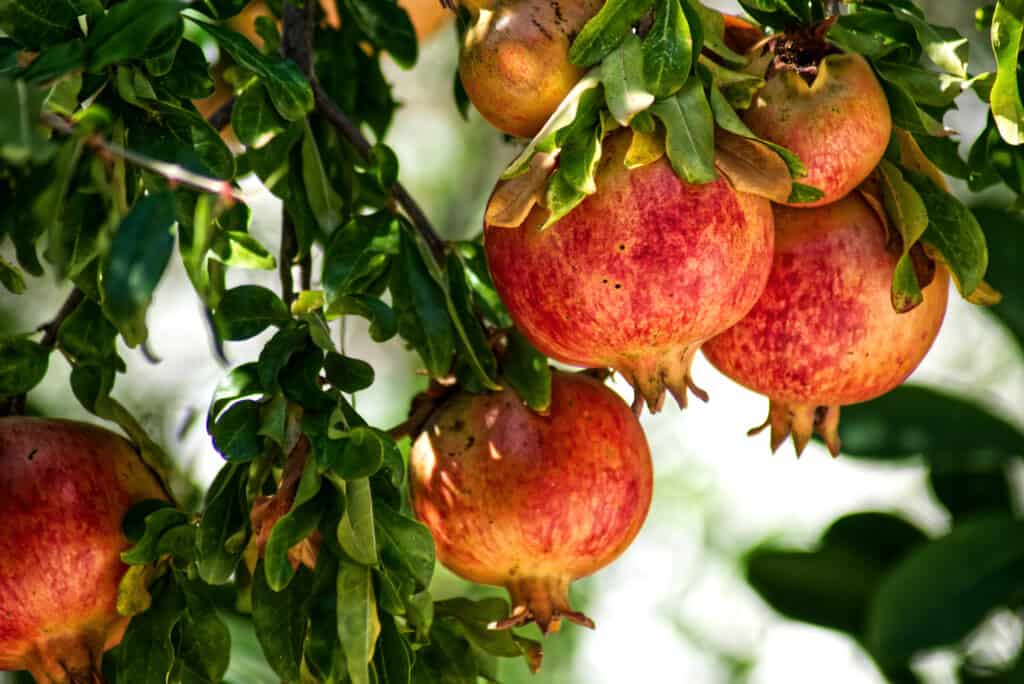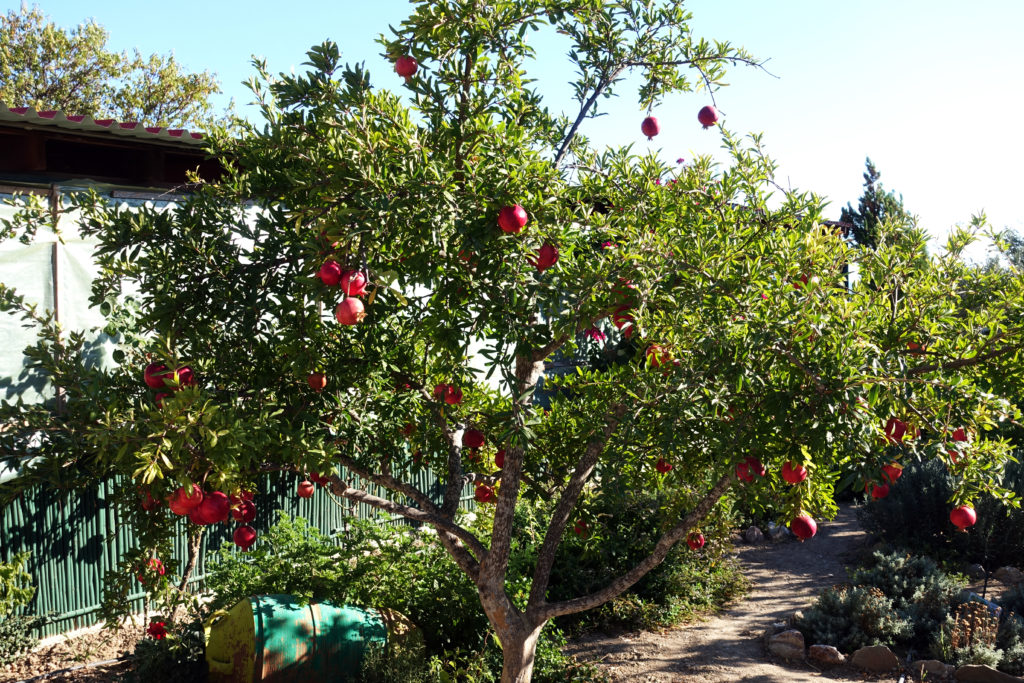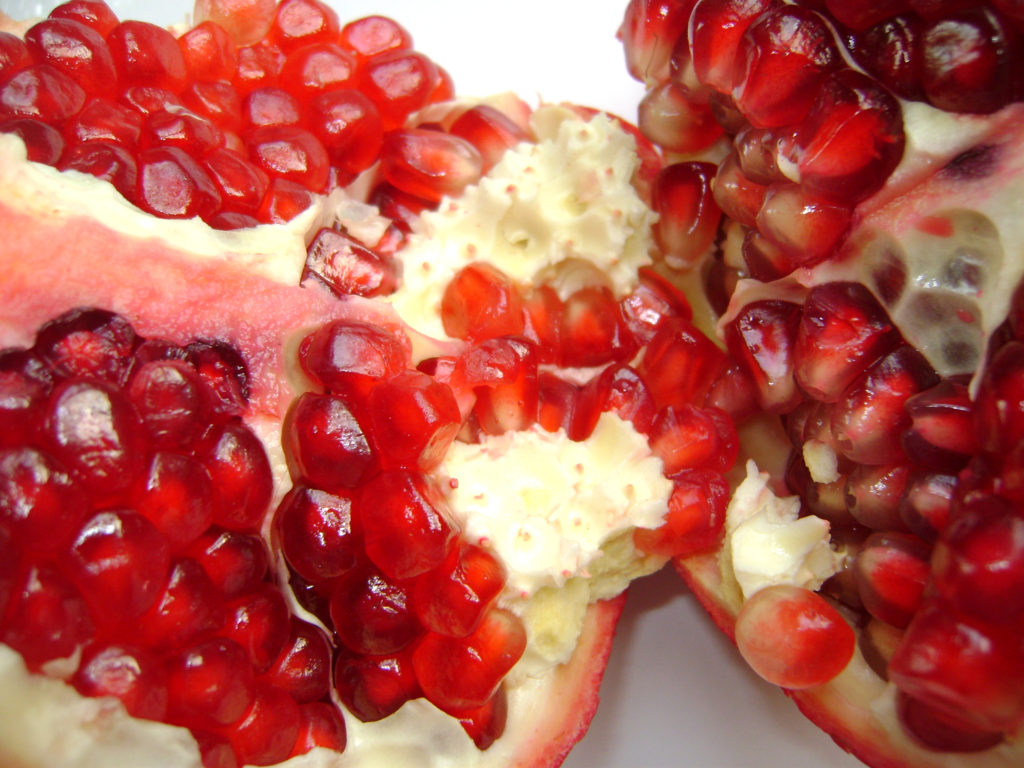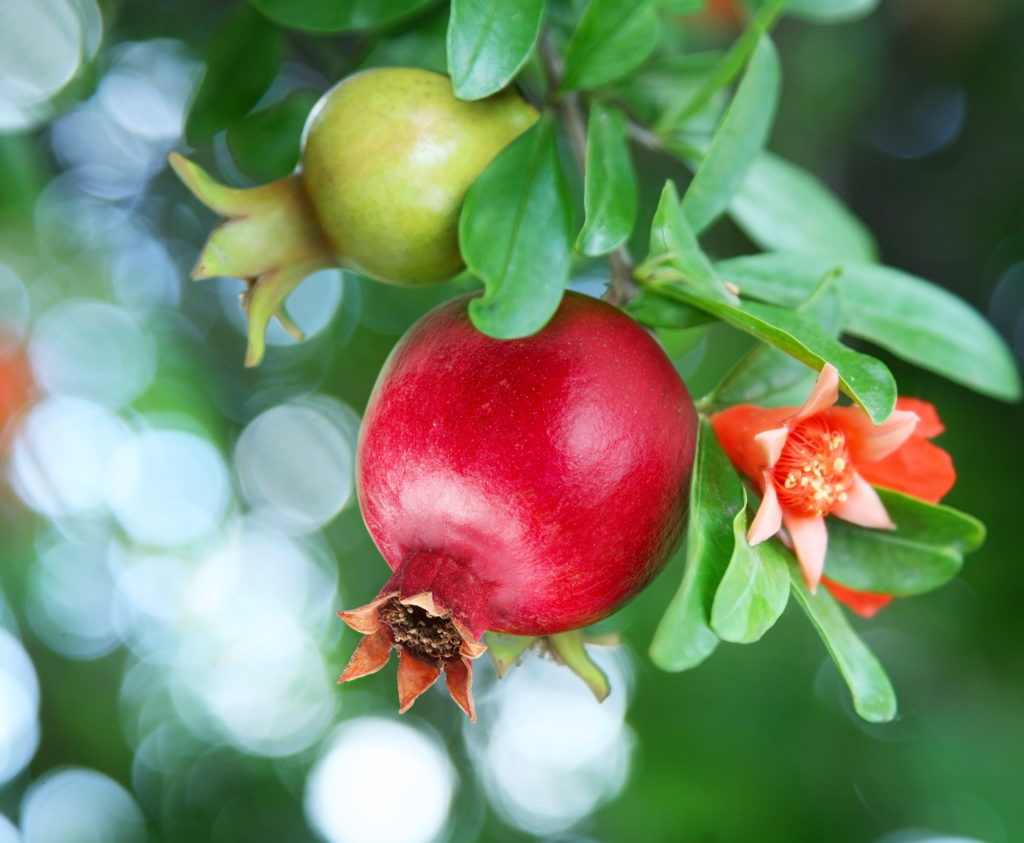Pomegranate fruits have a leathery hard skin; inside are hundreds of small seeds called arils, each surrounded by a juicy red pulp. The pomegranate can be grown as a bushy shrub or as a small tree. The fruits come to harvest from mid-summer through autumn.
Pomegranate seeds, pulp, and juice are both tart and sweet. Pomegranates can be eaten out of hand—although this can be a bit of a messy chore—or the bright red seeds can be used as a garnish for salads, fruit cups, and desserts. The juice adds a sweet-tart flavor to marinades and basting sauces and is used in punches and cocktails and is the basis for grenadine syrup.
Related articles:

Pomegranates grow best in hot, arid regions. There are cultivars that grow in slightly cooler regions. The pomegranate fruit tree is native from Iran to the Himalayas in northern India and is often grown in Mediterranean-climate regions of North America. (Spanish settlers brought the pomegranate to Florida, Arizona, and California in the seventeenth century.) In cold winter regions, pomegranates should be grown in a greenhouse where the minimum temperature does not dip below 50°F.
The botanical name of pomegranate is Punica granatum.
Here is your complete guide to growing pomegranates!
About pomegranates
- The pomegranate is a bushy deciduous shrub or tree that can grow 10 to 20 feet tall and 6 to 15 feet wide; it can be trained as a single-trunk small tree or grown multi-trunked.
- Thorny branches bear small, narrow, light green leaves that turn bright yellow in fall. New growth is tinged red.
- Showy pink to orange-red flowers bloom from spring to midsummer. Pomegranate flowers attract hummingbirds.
- The fruit is 2 ½ to 5 inches in diameter and features a prominent calyx (petallike projection) at the base.
- The skin is typically shades of pink to purplish red as it matures.
- The rind is hard, brownish-yellow to deep red; it forms a protective ball that is filled with papery honeycomb-like chambers containing many seeds each covered with a spongy white membranous tissue.
- Pomegranate has angular seeds with a soft to hard coat. Each seed (called aril) sac is filled with pink or whitish juicy pulp that has a sweet acid flavor. (Note: the juice of nearly all pomegranate varieties will leave a red stain.)
- Pomegranates are best adapted to arid regions with long, hot summers and cool winters. The fruit quality in humid climates is inferior. Fruit production is very limited or non-existent in regions with short, cool summers.
- Pomegranate plants bear at 1 to 4 years old. A pomegranate tree can live for 80 to 90 years.
Best climate and site for growing pomegranates
- Pomegranates grow best in hot, dry climates. USDA Zones 9 and 10. Pomegranates can grow without protection in USDA Zone 8. The pomegranate is hardy to 12°F. (Pomegranates originated in Middle East regions stretching from Iran to the Himalayas.) Fruit set is unlikely to occur in Zone 8 or cooler.
- Grow pomegranates in well-drained soil; deep loamy soil is best. Pomegranates can grow in sandy to clay soil. A soil pH of 5.5 to 7.5 is optimal.
- Pomegranates will survive in alkaline soils.
- Plant pomegranates in full sun in a location sheltered from the wind.
- Accumulation of heat will make the fruit sweeter.
Pomegranate pollination
- Pomegranates are self-fruitful.
- Grow two pomegranates if you have room; cross-pollination can increase the yield.
Spacing pomegranates
- Space pomegranates about 15 feet apart.
- Grown as a bush the pomegranate can grow 10 to 15 feet tall and wide. Plants can be trained to a single trunk and grown as a small tree to 20 feet tall or pruned to 10 to 12 feet tall and wide or less.
- Pomegranates can be grown as ornamentals. They can be used for background plants, a screen, an espalier, or as a barrier (because of the thorns). Pomegranates are also grown as decorative bonsai.

Planting pomegranates
- Pomegranates can be purchased bare-root, ball-and-burlapped, or container-grown.
- Plant bare-root plants in early spring after the last frost but before plants break dormancy. Plant bare-roots in late winter to allow then to establish root systems before summer heat.
- Ball-and-burlapped plants are also best planted in spring.
- Container-grown pomegranates can be planted any time during the year; however, avoid planting in hot, dry weather.
- Plant pomegranates in the warmest possible microclimate; place plants close by a building, wall, or fence that can collect solar heat during the day and radiate it out to the plant at night.
- Prepare a planting site in full sun that is sheltered from a prevailing breeze or wind.
- Work well-rotted compost or manure into the soil.
- Dig a hole half again as deep and twice as wide as the plant’s roots. Add a cupful of all-purpose fertilizer to the bottom of the hole.
- Set the plant in the hole so that the soil mark from the on the stem is level with the surrounding soil. Remove all twine and burlap from balled-and-burlapped trees. Spread the roots out in all directions.
- Re-fill the hole with half native soil and half aged compost or commercial organic planting mix; firm in the soil so that there are no air pockets among the roots. Water in the soil and create a modest soil basin around the trunk to hold water at watering time.
- After planting, water thoroughly with a high-phosphorus liquid starter fertilizer.
Container growing pomegranates
- Pomegranate can be grown in a container 18 inches deep and wide or larger.
- Plant in a commercial organic potting mix.
- Keep the soil evenly moist but not wet.
- Feed pomegranates growing in containers with an all-purpose fertilizer that is slightly higher in potassium.
- Repot the tree after two years into a container that is 24 inches wide and deep. If you do not repot, you may need to prune the roots.
- To keep pomegranates small, prune the top and roots each winter
- ‘Nana’, ‘Chico’, and ‘Multiflora; are two dwarf bush-size varieties for growing in a container.
Training Pomegranates
- Pomegranates can be trained to a single trunk by selecting a single stem that is straight and without bends or curves. Tie that stem to a stake. Remove all surrounding suckers as they appear. In the second and third years, select well-spaced lateral stems to train as scaffold branches.
- Pomegranate can be trained as a multi-trunk shrub by allowing five or six evenly spaced leaders or suckers to grow into permanent trunks. Once the multiple trunks are selected, prune away new suckers as they appear. Train the stems to a vase shape.
- Flowers are produced on short spurs found mostly on the outer edge of the tree, on two or three-year-old wood. Light dormant pruning of mature trees encourages the growth of new fruit spurs.
- Multi-trunk pomegranates bear fruit sooner than single-trunk plants and have an increased chance of surviving frost damage.
Pruning pomegranates
- Pomegranate can be grown as a bush or a tree with one or more trunks.
- The bush form can be used in backyards or hedgerows. Commercial growers train the plants as trees.
- Shorten pomegranate branches by 40 percent the first winter after planting.
- For the first 3 years, shorten shoots to encourage strong stem growth.
- In the following years, prune lightly once a year to encourage new fruit spurts to grow.
- Flowers and fruit develop on short spurs of two or three-year-old wood, primarily on the outer edge of branches.
- Prune mature plants lightly after the leaves have dropped in autumn or in late winter before leaf buds appear; this will stimulate new growth. Remove interfering or crossing branches thinning out crowded wood.
- Remove suckers unless they are replacing a damaged trunk.
- Prune to remove crossing and damaged branches.
- Fruit seldom requires thinning except if branches threaten to break from overload toward the tips. Where there is a heavy fruit set, thin fruits to 6 inches apart.
- If grown as a multi-trunk tree, remove suckers regularly to maintain the shape.
- Pomegranates can be espaliered and trained to grow against a wall; a warm south-facing wall is best.
Watering pomegranates
- Mature pomegranates are drought tolerant, but regular water is necessary for the best fruit quality.
- To establish new plants water every 2 to 4 weeks during the dry season.
- Pomegranates need very little water once established, but letting the root zone alternate between wet and dry can lead to cracked fruit, which spoils quickly.
- Near mature fruit will crack or split if the tree experiences dry conditions followed by rain or irrigation. Split fruit will become moldy and unusable.
- Soils that get summer rain off and on should be kept moist throughout the growing season; make sure the soil is very well drained.
- Keep soil evenly moist, particularly as harvest approaches; evenly moist soil will reduce fruit split.
Feeding pomegranates
- Feed pomegranates with compost tea or a dilute solution of fish emulsion every two weeks during the growing season. Feed pomegranates to the drip line. Rain and irrigation will take nutrients deep into the soil.
- Apply 1 pound of 10-10-10 organic fertilizer in late winter and early summer when the plant is young. Increase the amount of fertilizer until mature plants receive 3 pounds of 10-10-10 twice a year.
- Too much nitrogen fertilizer can result in fruit drop.
Pomegranate care
- Add several inches of aged compost or aged manure mulch around the base of plants each spring; the mulch should extend to the drip line.

Propagating pomegranates
- Pomegranate seeds germinate readily in warmer climates.
- Pomegranates can be propagated by hardwood cuttings; use 8 to 10-inch long ¼ to ½-inch diameter wood cut in late winter from the previous season’s shoot or sucker growth. Rooting can take up to two years.
Pomegranate pests and diseases
- Pomegranates are seldom bothered by pests or diseases.
- Leaf-footed plant bugs may drill holes in fruit in desert regions; control with neem oil or insecticidal soap.
- Check leaves occasionally for signs of mites, leafrollers, or whitefly. Spray these pests with insecticidal soap or suffocate with horticultural oil.
- Alternaria fungus causes heart rot infection of the fruit. This infection starts in the flower and progresses to the interior of the fruit partially destroying the fruit cavity. There is no control.
- Deer may feed on pomegranate leaves and nibble on young trees.
Fall and winter pomegranate care
- Prune pomegranates in winter. See Pruning above.

Harvesting pomegranates
- Pomegranates harvest comes mid-summer through fall, about 5 to 7 months after the plant flowers.
- Harvest when the skin turns a distinctive yellow-orange to deep reddish purple.
- If you hear the sound of grains cracking when you press the fruit lightly, it is ready to pick.
- Harvest pomegranate fruit with clippers when skins are fully colored bright red to yellowish-brown.
- Fruit will split if left on the tree after it ripens.
- Pomegranates do not continue to develop sugar after they are picked.
Storing pomegranates
- Pomegranates can be stored for several weeks at room temperature; the skin will darken off the tree.
- Refrigerated fruit will store for seven months at 32° to 41°F. and about 80 percent humidity.
- The flavor of pomegranate fruit improves with age and the seeds become softer and more edible.
- Spit fruit will deteriorate quickly.
- Pomegranate juice will keep in the refrigerator for 2 to 3 days after squeezing.
Pomegranates in the kitchen
- Pomegranate fruit can be eaten fresh or juiced.
- To remove the seeds, cut the fruit into sections and peel the skin back to expose seeds that can be eaten whole.
- To juice the fruit, cut the fruit in half and use a citrus juicer.
- You can roll the whole fruit on a hard surface to burst the juice sacks; insert a straw through a hole in the skin and suck the juice.
- Use pomegranate seeds in green and fruit salads.
- Pomegranate juice can be used to make jams, jellies, and other preserves.
- Juice can be used in fruit smoothies, marinades, and sauces.
Pomegranate frequently asked questions
Q: My pomegranate tree flowered but there was no fruit; what happened?
A: Pomegranate trees will not begin to bear fruit until about the third year. After that, cool weather, too much water or poor drainage, and too much nitrogen fertilizer can hinder fruit set and growth.
Q: How do I know pomegranate fruit is ripe?
A: The following are signs of ripening pomegranate fruit: the skin begins to turn color from green to pink or red (check the color of ripe fruit for the variety you are growing; the fruit becomes less rounded and takes on a hexagonal shape; the stem and blossom end of the fruit begins to flatten; the fruit comes away from the stem with a slight twist.
Q: Why do pomegranate fruits split?
A: Splitting pomegranate fruit is a sure sign the fruit is ripe and should be picked. Fruit can also split as a result of the soil going dry and then being overwatered; the fruit takes up excess water.
Q: What’s the best way to eat pomegranate fruit?
A: Cut the fruit in half, score the outside ridges so that the skin peels or bends back, and peel the skin away as you nibble the seeds. You can also roll the unpeeled fruit on a hard surface to break up the seeds then cut and peel the skin back to eat the seeds.
Q: Why does a pomegranate fruit look rotten inside?
A: There are several possible causes of fruit becoming rotten: Alternaria fruit rot is a fungal disease caused by excess rainfall; leaf-footed bugs can carry fungal diseases and can drill through the skin; old fruit was left too long on the tree cracked and spoiled.
Pomegranate varieties to grow
There are a few dozen pomegranate varieties. Here are a few popular varieties and cultivars:
- ‘Ambrosia’: very large fruit with pale pink skin and purple pulp; sweet-tart flavor; fruits three times larger than ‘Wonderful’.
- ‘Balegal’: large fruit; pale pink skin; sweet flavor; hardy to zone 7.
- ‘Christina’: medium size fruit; deep red skin; pale pink seeds and juice; grows well in Florida and the Southeast.
- ‘Crab’: medium to large fruit; bronze skin; tart, rich flavor; productive plant.
- ‘Early Wonderful’: large fruit; red skin; tart flavor; very productive.
- ‘Eversweet’: medium-size fruit; early to harvest; red skin; almost seedless with transparent red pulp; clear non-staining juice; widely adapted; seeds easy to eat.
- ‘Fleishman’: medium-size fruit; pink skin; pink juice is very sweet; excellent quality; pink flowers.
- ‘Granada’: small to medium size fruit; crimson skin; pink pulp and juice; bears pink flowers; medium-sized tree.
- ‘Kashmir’: pinkish-red fruit; seeds with intense flavor; used for juice.
- ‘Plantation Sweet: medium to large fruit; red skin and red juice; small tree to 6 feet tall; good grower in containers.
- ‘Pink Satin’: pinkish-red fruit; soft seeds; the juice is non-staining.
- ‘Red Silk’: large fruit; early harvest; light greenish pink skin; pink juice, very sweet; productive even when young.
- ‘Sweet’: medium-size fruit; pink skin; pink juice, very sweet; softer seeds than ‘Wonderful’.
- ‘Utah Sweet’: medium-sized fruit; pink skin; sweet flavor; soft seeds; pink flowers.
- ‘White’: large fruit; cream skin tinged light pink; clear, non-staining juice; sweet-tart flavor; productive plant.
- ‘Wonderful’: large fruit; orange-red flower; deep purple-red skin, pulp, and juice; best for juicing than eating out of hand; most common variety.
Also of interest:
Related articles:
Planning the Home Fruit Garden
Garden Planning Books at Amazon:
- Vegetable Garden Almanac & Planner
- Kitchen Garden Grower’s Guide Vegetable Encyclopedia
- Vegetable Garden Grower’s Guide
- Tomato Grower’s Answer Book
More fruit-growing articles:
Learn how to plant, grow, prune, and harvest your favorite fruits. Click below for all you need to know.
- Apple
- Apricot
- Avocado
- Banana
- Blackberry
- Blueberry
- Cantaloupe
- Chayote
- Cherimoya
- Cherry
- Citrus
- Clementine
- Cranberry
- Currants
- Elderberry
- Feijoa
- Fig
- Gooseberry
- Grape
- Grapefruit
- Guava
- Kiwifruit
- Kumquat
- Lemon
- Lime
- Loquat
- Mandarin
- Mango
- Melon
- Mulberry
- Muskmelon
- Nectarine
- Olive
- Orange
- Papaya
- Passion Fruit
- Peach
- Pear
- Persimmon
- Pineapple
- Pineapple Guava
- Plantain
- Plum
- Pomegranate
- Pumpkin
- Quince
- Raspberry
- Strawberry
- Tangelo
- Tangerine
- Tangor
- Watermelon















